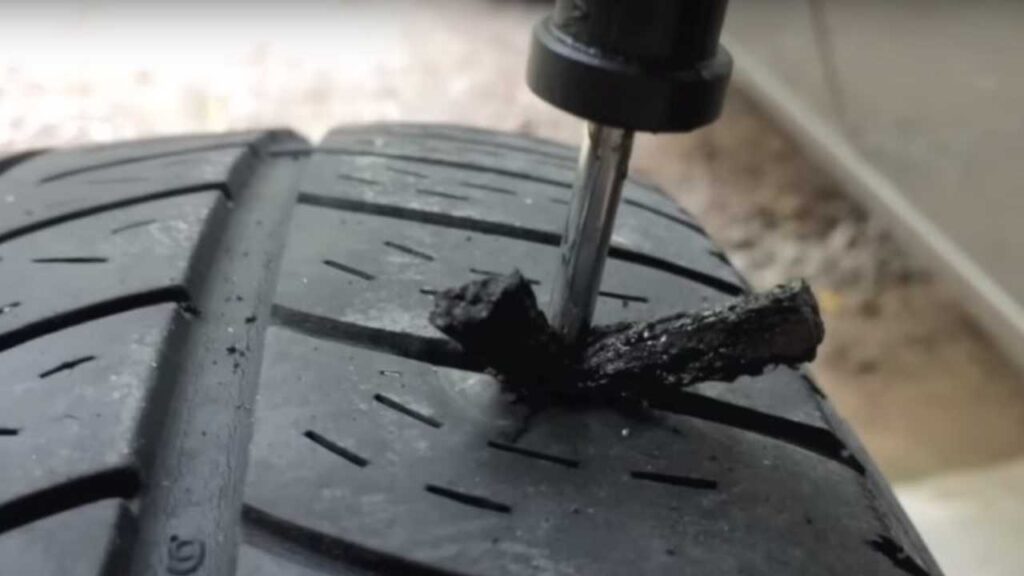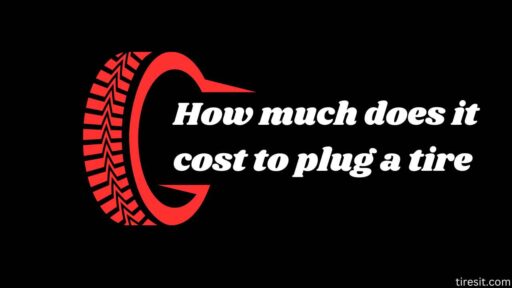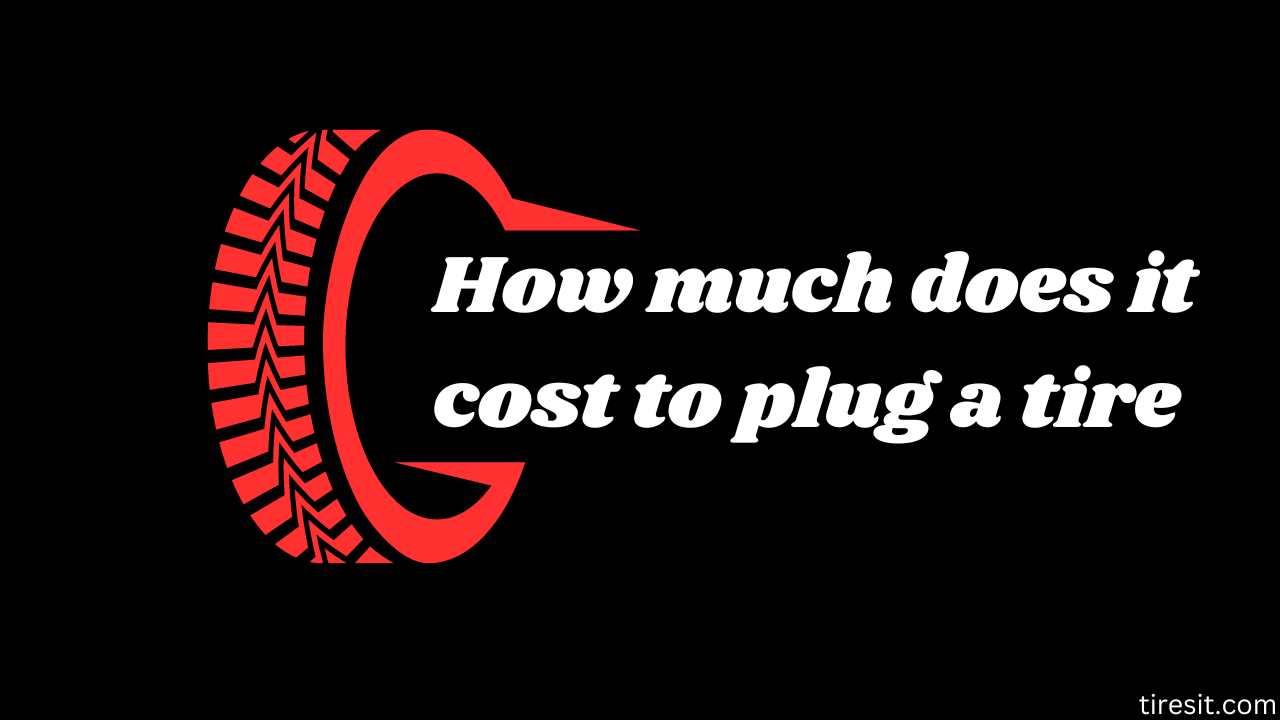Uncover the expenses related to How much does it cost to plug a tire procedure on our website. Learn about the average cost of plugging a tire and make informed decisions. Start exploring now!
Your vehicle moves around the world with four points of contact on the land. Therefore, it is important that you keep your tires in good condition for your own safety and comfort while traveling. But what if one of them gets punctured? Can you fix it yourself, or should you go to a car repair shop? And how much will this dent your budget? This detailed manual will answer all these questions and tell you everything about tire plugging so that even if you do not know a thing about mechanics, you can still feel like a knowledgeable driver.
Why plugging your How much does it cost to plug a tire
Plugging the tire does more than just keep your car running smoothly – it also ensures safe driving for both yourself and other road users. A leaky tire can quickly result in a blowout which causes loss of control over the vehicle leading to potential accidents.
Not only does plugging prevent accidents from happening but it also saves money because buying new tire pressure would be much more expensive. As a matter of fact, plugging costs significantly less than replacement.

Credit: www.pexels.com
Factors That Influence The Price Of Tyre Plugs
How much does it cost to plug a tire? The fees for plugging vary depending on some factors such as; type and size of your vehicle, location & depth of puncture as well as type of tire used among others. On average expect to spend between $10-$30 for DIY repair kit or approximately $20-$60 at an auto shop.
However these are only rough estimates; actual expenses may differ depending on other factors specific to your situation e.g., performance/racing tyres or run flat ones could be more expensive due specialized design requirements during patching process etcetera…
DIY Tire Plug vs Professional Fix
If there’s a hole in my bicycle wheel tube, should I fix it myself or take it somewhere? Although using kits sold in stores lets anybody patch their own tubes at home, one needs to put into consideration their capabilities and skills versus the gravity of damage. In such a case, if you doubt your ability to handle this task properly, then let an expert do the work for you.
The other thing about doing it yourself is that sometimes DIY patching may not hold up for long, especially if 1) The area where there’s a puncture cannot be easily reached or 2) the Hole size exceeds certain limits. In any of these instances, there’s a possibility that more harm could come upon your tire.
Contrarily professional repairs are often characterized by use advanced tools plus techniques like inner tube patches which provide stronger adhesion compared with plugs. However all these additional features may attract higher charges.
How To Avoid Future Flat Tires
Save money on plugging by ensuring no future flats: Regularly inspect your tires for signs of aging including worn-out threads or dry rotting rubber – besides also steer clear sharp objects encountered while driving around town.
Moreover, inflation levels should be maintained within the manufacturer’s recommended range, as under-inflation can potentially cause blowouts resulting from overheating.
- If done incorrectly, a DIY tire plug can cause further damage to the tire.
- Limited effectiveness. While a tire plug can provide a temporary fix, it is not as reliable or long-lasting as a professional patch.
- Lack of warranty. If you perform your own repair and it fails, you will need to pay for another repair or replacement out of pocket.
The Professional Route
Pros of Professional Repair
- Expertise: Tire professionals have the knowledge and experience to properly assess the damage and choose the most appropriate repair method.
- Long-term reliability: A professional patch is more likely to provide a lasting solution to a punctured tire.
- Warranty coverage: Many professional repairs come with a warranty that guarantees their effectiveness for a certain period of time.
Cons of Professional Repair
- Cost: Getting your tire professionally repaired can be more expensive than purchasing a DIY kit.
- Time-consuming: Depending on the availability of appointments at your local shop, you may need to wait longer for a professional repair than if you were able to do it yourself at home.
- Ultimately, the decision between DIY and professional tire repair depends on factors such as cost, convenience, and the severity of the damage.
- Safety Issues: This is a repair you have not done before, so there is a learning curve, and it’s crucial to get the plug sealed properly.
- Tread Depth Check: Checking your tire tread can be done while plugging the tire. Some DIYers may lack the tools or know-how for this step.
Choosing Professional Help
Pros of Professional Repair
Expertise. Tire professionals are trained and equipped with the necessary tools to assess your tire correctly and fix it.
General Problem Understanding. They can identify any underlying problems with your tire that might slip through an average driver’s attention.
Cons of Professional Repair
Costs. Depending on where you live, prices can range from $20 to $50 for services rendered, and the complexity of repair also affects this range.
Time. It usually takes more time when someone else does something for you than if you did it yourself; therefore, having a professional fix may sometimes cause significant inconvenience due to the waiting periods involved.
Breaking Down Costs
The costs associated with fixing a damaged tire are not standardized because different factors come into play that influence how much money one will spend on repairing a flat wheel.
DIY Plug Materials You’ll Need
- Tire plug kit – $5 to $20
- Optional rubber cement – $3 to $5
- Pro Labor & Service Costs
- Tire plug repair – $20 to $50
- Tire rotation (additional service) – $15 to $35
- Step-by-Step Guide On How To Plug Your Tire
Are you confident enough to give it a try? Here is what needs doing:
Step 1: Find The Puncture Hole(s)
Tools Needed: Pliers or similar tools for removing foreign objects from punctured area(s).
Safety First: Make sure your vehicle is parked on level ground, parking brake engaged, wheels chocked, etc…
Step 2: Prepping The Hole(s)
Remove Object: Using pliers carefully, pull out whatever object caused the puncture(s).
Ream Hole: Take tool provided with your repair kit to ream out each puncture which will ready them for plugging later on.
Step 3: Inserting Plug(s)
Thread Plug: Insert plug through a needle-like tool provided in the kit and gently thread it all the way down this device until approximately half its length remains exposed at one end while still attached to said implement’s other side.
Insert Plug: Carefully insert the plugged end into the hole created by removing foreign object(s) from step two, pushing through until about 1/4” or so extends beyond the tread surface of the tire.
Step 4: Seal Repair
Trim Excess Plug: Use sharp blade such as utility knife etc… (found in most kits) to trim off any excess protruding above tread surface level, thereby making it flush with rest of rubber around punctured area(s).
Apply Rubber Cement: If desired, apply a thin layer of included rubber cement over the entire surface around the patched spot, which can help maintain a better seal between the plug itself and the inner liner of the wheel once inflated back a, gain, etc…
When To Go Hands Off
While DIY is fun and often saves money, there are times when professional assistance trumps doing things oneself.
Multiple Leak Points On Your Tire
One hole equals one plug; therefore if more than one hole exists then multiple plugs need installing thus go see a pro for repairs.
High Mileage Tires
Age may have weakened your tires beyond what the naked eye can reveal; hence, seeking advice from professionals who deal with such matters routinely might be wise.
Overly Large Hole(s)
Small holes get fixed via plugging but larger ones require patching where an inner liner patch must be installed from inside followed by outside patch work too; this kind typically necessitates the involvement of specialists only.
Caring For Your Tires
Tire safety starts with you; therefore, adopt these tips below so as to elongate their lifespan and reduce chances of getting punctures or leaks:
Check tire pressure once each month, ensuring it conforms to recommended levels.
Rotate wheels after covering 5000-8000 miles, thereby promoting even wear distribution across them.
Always check the thickness of your tires and buy new ones when they wear down to 2/32 of an inch or less.
These suggestions will help you deal with small punctures on your own or let you know when it’s time to go to a mechanic. Knowing about the repair process and what it costs can help you make a good decision while keeping your car running smoothly. So, if you find yourself with a flat tire next, just remember to stay calm, evaluate the situation, and determine what is best for your tires. Always put safety first and be ready for anything on the road. Have a good trip!
Frequently Asked Questions (FAQs)
Can I use tire plugs in any kind of tire?
Generally, tire plug kits are designed for tubeless tires found on cars, SUVs, and light trucks. They’re not recommended for bike tires or large commercial truck tires that require different repair methods.
How long do tire plugs last?
When installed correctly, a tire plug can hold anywhere from 7,000 to 10,000 miles before it should be replaced or until the tread becomes too thin. However, it’s always a good idea to have the tire looked at by a professional from time to time.
Is it safe to drive fast after plugging my tire?
Yes – driving on a plugged tire is generally considered safe. However, most experts suggest not exceeding speeds of 50 mph during the first day after having your flat fixed. Additionally, always inspect the stability of the plug itself and overall condition of the whole wheel before taking long trips or doing any high-speed driving.
Can I put more than one plug in my tire?
You can put as many plugs as you want into one tire; however, repeating patches through holes isn’t usually recommended because each penetration weakens structural integrity – multiple patches further compromise safety.
Does plugging my punctured radial void its warranty protection?
Some manufacturers may not honor any remaining warranty on tires repaired with plugs that don’t meet their specifications. It is important to be aware of your rights under federal law, but you should read the tire’s warranty info and consult with an authorized dealer if unsure about what constitutes proper care.
Conclusion of How much does it cost to plug a tire
After exploring the topic “How much does it cost to plug a tire,” it becomes evident that the cost of plugging a tire can vary depending on various factors such as the location, type of vehicle, the extent of damage, and the quality of service provider. While the average cost typically ranges from $10 to $30 for a simple plug repair, it is essential to prioritize safety and quality service over cost considerations when addressing tire issues. By understanding the potential costs involved and seeking professional assistance promptly, individuals can ensure the longevity of their tires and maintain road safety for themselves and others.





